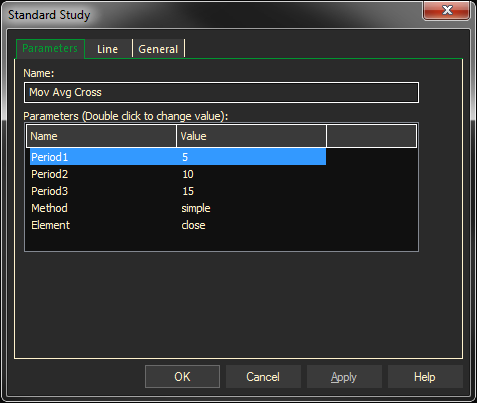The functions listed below have been pre-defined and are already available on your ProphetX Standard Study list.
Combining Studies
Most of the functions listed here can also be used as elements in a study or analysis you create yourself. To create your own study, refer to Creating a New User Custom Study. When you use these functions in a study you create, the field named Series can be used as the symbol parameter rather than a specific instrument symbol.
Changing Parameters
You can change the calculation parameters of most ProphetX studies as you open them or after they are displayed.
General Parameters
- Two common parameters used in studies are Element and Period.
- For Element, Close is generally the default.
- Periods generally indicate the number of time intervals to be used to calculate each point in the study.
- For example, if you select a moving average for a daily chart and enter a period of 5, then the previous 5 intervals (such as days, minutes, weeks, etc.) will be considered for each data point in the moving average.
The Standard Study Dialog Box
- In the Name entry. name of a previously designed study will display. If you are creating a new study, enter a unique name (may not use a ProphetX name here) in this entry
- Type the formula for the study in the Formula entry. If using a pre-defined study, modify it to create the new study criteria. If not using system parameters, delete any parameters listed in the Parameters section. When finished select the OK button. The study will display in your study list and can be added to the chart as outlined above.
In the study’s parameters list, the Element entry may also include HLC3 which will average high, low, and close on studies where these elements exist. Double-click on the method of element to choose the method or element you want to use
Ex: Moving Average, RSI, etc, when selected, HLC3 will average the High, Low, and Close data where ever it exists. It will calculate all existing and non-blank prices. If it is blank it’s ignored and the calculations are based on the other existing prices.

Moving Average Calculation Methods
When a study is based on a moving average, Method (the method of calculation) is included as a parameter. The standard moving average calculates the arithmetic mean of a series of prices. The exponential moving average gives less recent data progressively less weight. The weighted moving average gives more weight to recent data using a linearly weighted ramp. The running moving average uses only the previous position moving average and the current data to calculate each new position.
More Information on Studies
Note: Some studies cannot be entered as shortcuts or combined with others. For a complete list of studies included in ProphetX please see Standard Studies in the Table of Contents.
Standard Study Parameters
This is a condensed list of the standard studies and their parameters that can be used in creating a User Defined study. Complete information for each of these studies is located under Standard Studies listed later in this help section.
Absolute Values – ABS(Symbol or Formula)
Acceleration — ACCEL (Element(Symbol), Periods, Difference Interval)
Accumulation Swing Index — ASWING (Symbol, Limit Move)
ADX — ADX(Symbol, Periods)
Average Momentum — AVGMO (Element(Symbol), Periods, Averaging Period, Method)
Average True Range – ATR (Symbol,14)
Avg — AVG (Symbol)
Bollinger Bands — BOLL (Element(Symbol), Period, Method)
Calendar Average — CALAVG(Symbol, Element)
Chaikin Money Flow — CMF(Symbol, Periods)
Close Price — Close (Symbol)
Commodity Channel Index — CCI(Symbol, Periods, Mean Deviation, Element)
Contract Average — CONAVG(Symbol, Element)
Correlation — CORRL(Symbol,Symbol)
Cross — CROSS (Symbol, Rule)
Departure — DPRT (Element(Symbol), Period1, Period2)
Directional Indicator — DI(Symbol, Periods)
Disparity Ratio — DSP (Element(Symbol), Period, Weight, Method)
DMI — DMI (Symbol, Period)
DSpread — DSpread (Symbol)
Envelope — ENV (Element(Symbol), Period, Vert Shift, Method)
High Price — HIGH (Symbol)
Highest — HIGHEST (Symbol, Period)
HLC3 — HLC3(Symbol)
HLO3 — HLO3(Symbol)
Ichimoko – ICHI(Symbol, Period1, Period2, Period3)
Keltner Channel — Keltner (Symbol, Keltner, Kelt Up, Kelt Lo, Mov. Avg.)
Lag — LAG (Symbol, Period)
Low Price — LOW (Symbol)
Lowest — LOWEST (Symbol, Period)
MACD — MACD (Symbol, Fast Period, Slow Period, Smoothing Period)
Mid Bar — MID (Symbol)
Momentum — MO (Element(Symbol), Period)
Mov Avg Cross — MAX 1(Element(Symbol), Period, Weight, Method)
Moving Average — MOV (Element(Symbol), Period, Vertical Shift, Horizontal Shift, Method)
Moving Correlation – MCORL(1st Symbol,2nd Symbol,Periods)
On Balance Volume — OBV(Symbol)
Open Interest — OI(Symbol)
Open Price — OPEN(Symbol)
Parabolic SAR — ParSAR(Symbol, Step, Max)
Percent Change – PCNTCHG (Symbol,Increment)
Percent R — PCNTR (Symbol, Period)
Psychological Line — PSY (Symbol, Period)
Relative Strength Index — RSI (Element(Symbol), Period, Smoothing Period)
Standard Deviation — STDEV (Symbol, Period)
Stochastic — STOCH (Symbol,%K,%D,%K slow,Moving Average Type)
Swing Index — SWING (Symbol, Limit Move)
Total Open Interest — TOI(Symbol)
Total Volume — TVOL(Symbol)
Trix – TRIX (Symbol, Periods)
Volatility — VLTY (Symbol, Period, Annual Days, Type)
Volume (study only)
VWAP — VWAP(Symbol, Periods, Element)